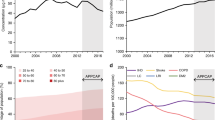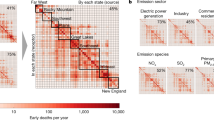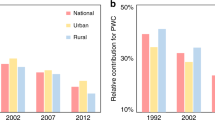Abstract
Between 2002 and 2017, China’s gross domestic product grew by 284%, but this surge was accompanied by a similarly prodigious growth in energy consumption, air pollution and air pollution-related deaths. Here we use a combination of index decomposition analysis and chemical transport modelling to quantify the relative influence of eight different factors on PM2.5-related deaths in China over the 15-year period from 2002 to 2017. We show that, over this period, PM2.5-related deaths increased by 0.39 million (23%) in China. Emission control technologies mandated by end-of-pipe control policies avoided 0.87 million deaths, which is nearly three-quarters (71%) of the deaths that would have otherwise occurred due to the country’s increased economic activity. In addition, energy-climate policies and changes in economic structure have also became evident recently and together avoided 0.39 million deaths from 2012 to 2017, leading to a decline in total deaths after 2012, despite the increasing vulnerability of China’s ageing population. As advanced end-of-pipe control measures have been widely implemented, such policies may face challenges in avoiding air pollution deaths in the future. Our findings thus suggest that further improvements in air quality must not only depend on stringent end-of-pipe control policies but also be reinforced by energy-climate policies and continuing changes in China’s economic structure.
This is a preview of subscription content, access via your institution
Access options
Access Nature and 54 other Nature Portfolio journals
Get Nature+, our best-value online-access subscription
$29.99 / 30 days
cancel any time
Subscribe to this journal
Receive 12 print issues and online access
$259.00 per year
only $21.58 per issue
Buy this article
- Purchase on Springer Link
- Instant access to full article PDF
Prices may be subject to local taxes which are calculated during checkout



Similar content being viewed by others
Data availability
The MEIC emission inventory is available from www.meicmodel.org. The dataset generated during this study is available in the figshare repository https://doi.org/10.6084/m9.figshare.14493375. Source data are provided with this paper.
Code availability
The code of the WRF model is available at https://www2.mmm.ucar.edu/wrf/users/download/get_sources.html. The code of the CMAQ model is available at https://github.com/USEPA/CMAQ/tree/5.0.1. The codes used for analysing data are available in the figshare repository https://doi.org/10.6084/m9.figshare.14493375.
References
National data. National Bureau of Statistics of China http://data.stats.gov.cn (2018, 2019).
Zhang, Q., He, K. & Huo, H. Cleaning China’s air. Nature 484, 161–162 (2012).
Cohen, A. J. et al. Estimates and 25-year trends of the global burden of disease attributable to ambient air pollution: an analysis of data from the Global Burden of Diseases Study 2015. Lancet 389, 1907–1918 (2017).
Circular of the State Council on Printing Out and Distribution of the National “11th Five-Year Plan” for Environmental Protection Report No. Guofa [2007] 37 (in Chinese) (State Council of the People’s Republic of China, 2007); http://www.gov.cn/zwgk/2007-11/26/content_815498.htm
Guidelines of the Eleventh Five-Year Plan for National Economic and Social Development of the People’s Republic of China (in Chinese) (State Council of the People’s Republic of China, 2006); http://www.gov.cn/ztzl/2006-03/16/content_228841.htm
Circular of the State Council on Printing Out and Distribution of the National “12th Five-Year Plan” for Environmental Protection Report No. Guofa [2011] 42 (in Chinese) (State Council of the People’s Republic of China, 2011); http://www.gov.cn/zwgk/2011-12/20/content_2024895.htm
Circular of the State Council on Printing out and Distribution of the 12th Five-Year Plan for Energy Saving and Emission Reduction Report No. Guofa [2012] 40 (in Chinese) (State Council of the People’s Republic of China, 2012); http://www.gov.cn/zwgk/2012-08/21/content_2207867.htm
Notice of the General Office of the State Council on Issuing the Air Pollution Prevention and Control Action Plan Report No. Guofa [2013] 37 (in Chinese) (State Council of the People’s Republic of China, 2013); http://www.gov.cn/zwgk/2013-09/12/content_2486773.htm
Zhang, Q. et al. Drivers of improved PM2.5 air quality in China from 2013 to 2017. Proc. Natl Acad. Sci. USA 116, 24463–24469 (2019).
Zheng, B. et al. Trends in China’s anthropogenic emissions since 2010 as the consequence of clean air actions. Atmos. Chem. Phys. 18, 14095–14111 (2018).
Schreifels, J. J., Fu, Y. & Wilson, E. J. Sulfur dioxide control in China: policy evolution during the 10th and 11th Five-year Plans and lessons for the future. Energy Policy 48, 779–789 (2012).
Xue, T. et al. Rapid improvement of PM2.5 pollution and associated health benefits in China during 2013–2017. Sci. China Earth. Sci. 62, 1847–1856 (2019).
Ma, Z., Liu, R., Liu, Y. & Bi, J. Effects of air pollution control policies on PM2.5 pollution improvement in China from 2005 to 2017: a satellite-based perspective. Atmos. Chem. Phys. 19, 6861–6877 (2019).
Li, M. et al. Anthropogenic emission inventories in China: a review. Natl Sci. Rev. 4, 834–866 (2017).
Ang, B. W. The LMDI approach to decomposition analysis: a practical guide. Energy Policy 33, 867–871 (2005).
Community multiscale air quality modeling system. US Environmental Protection Agency https://www.epa.gov/cmaq (2019).
Burnett, R. et al. Global estimates of mortality associated with long-term exposure to outdoor fine particulate matter. Proc. Natl Acad. Sci. USA 115, 9592–9597 (2018).
Zhou, M. et al. Mortality, morbidity, and risk factors in China and its provinces, 1990–2017: a systematic analysis for the Global Burden of Disease Study 2017. Lancet 394, 1145–1158 (2019).
Lei, Y., Zhang, Q., He, K. B. & Streets, D. G. Primary anthropogenic aerosol emission trends for China, 1990–2005. Atmos. Chem. Phys. 11, 931–954 (2011).
Liu, F. et al. High-resolution inventory of technologies, activities, and emissions of coal-fired power plants in China from 1990 to 2010. Atmos. Chem. Phys. 15, 13299–13317 (2015).
Wu, Y. et al. On-road vehicle emissions and their control in China: a review and outlook. Sci. Total Environ. 574, 332–349 (2017).
Lelieveld, J., Evans, J. S., Fnais, M., Giannadaki, D. & Pozzer, A. The contribution of outdoor air pollution sources to premature mortality on a global scale. Nature 525, 367–371 (2015).
Yu, H. et al. Interannual variability and trends of combustion aerosol and dust in major continental outflows revealed by MODIS retrievals and CAM5 simulations during 2003–2017. Atmos. Chem. Phys. 20, 139–161 (2020).
Gu, Y. et al. Impacts of sectoral emissions in China and the implications: air quality, public health, crop production, and economic costs. Environ. Res. Lett. 13, 084008 (2018).
Chen, W. H. et al. Regional to global biogenic isoprene emission responses to changes in vegetation from 2000 to 2015. J. Geophys. Res. 123, 3757–3771 (2018).
Maji, K. J. Substantial changes in PM2.5 pollution and corresponding premature deaths across China during 2015–2019: a model prospective. Sci. Total Environ. 729, 138838 (2020).
Wei, Y., Wang, Z., Wang, H., Li, Y. & Jiang, Z. Predicting population age structures of China, India, and Vietnam by 2030 based on compositional data. PLoS ONE 14, e0212772 (2019).
World Economic Outlook: Growth Slowdown, Precarious Recovery (International Monetary Fund, 2019).
Li, K. et al. Anthropogenic drivers of 2013–2017 trends in summer surface ozone in China. Proc. Natl Acad. Sci. USA 116, 422–427 (2019).
Li, K. et al. A two-pollutant strategy for improving ozone and particulate air quality in China. Nat. Geosci. 12, 906–910 (2019).
Gallagher, K. S., Zhang, F., Orvis, R., Rissman, J. & Liu, Q. Assessing the policy gaps for achieving China’s climate targets in the Paris Agreement. Nat. Commun. 10, 1256 (2019).
Huo, H. et al. Examining air pollution in China using production- and consumption-based emissions accounting approaches. Environ. Sci. Technol. 48, 14139–14147 (2014).
Watts, N. et al. Health and climate change: policy responses to protect public health. Lancet 386, 1861–1914 (2015).
West, J. J. et al. Co-benefits of mitigating global greenhouse gas emissions for future air quality and human health. Nat. Clim. Change 3, 885–889 (2013).
Vandyck, T. et al. Air quality co-benefits for human health and agriculture counterbalance costs to meet Paris Agreement pledges. Nat. Commun. 9, 4939 (2018).
Rauner, S., Hilaire, J., Klein, D., Strefler, J. & Luderer, G. Air quality co-benefits of ratcheting up the NDCs. Climatic Change 163, 1481–1500 (2020).
Li, N. et al. Air quality improvement co-benefits of low-carbon pathways toward well below the 2°C climate target in China. Environ. Sci. Technol. 53, 5576–5584 (2019).
National Bureau of Statistics of China Regional Input–Output Table of China 2002, 2007, 2012 (China Statistics Press, 2008, 2011, 2016).
National Bureau of Statistics of China China Industry Statistical Yearbook 2013, 2017 (China Statistics Press, 2013, 2017).
National Bureau of Statistics of China China Yearbook of Agricultural Price Survey 2018 (China Statistics Press, 2018).
National Bureau of Statistics of China China Price Statistical Yearbook 2016–2018 (China Statistics Press, 2016–2018).
National Bureau of Statistics of China China Statistical Yearbook 2018 (China Statistics Press, 2018).
National Bureau of Statistics of China China Energy Statistical Yearbook 2005, 2016, 2018 (China Statistics Press, 2006, 2017, 2019).
Skamarock, W. et al. A Description of the Advanced Research WRF Version 3, NCAR Technical Note, Mesoscale and Microscale Meteorology Division (National Center for Atmospheric Research, 2008).
Zheng, B. et al. Heterogeneous chemistry: a mechanism missing in current models to explain secondary inorganic aerosol formation during the January 2013 haze episode in North China. Atmos. Chem. Phys. 15, 2031–2049 (2015).
Zheng, Y. et al. Air quality improvements and health benefits from China’s clean air action since 2013. Environ. Res. Lett. 12, 114020 (2017).
Bey, I. et al. Global modeling of tropospheric chemistry with assimilated meteorology: model description and evaluation. J. Geophys. Res. 106, 23073–23095 (2001).
Li, M. et al. MIX: a mosaic Asian anthropogenic emission inventory under the international collaboration framework of the MICS-Asia and HTAP. Atmos. Chem. Phys. 17, 935–963 (2017).
Guenther, A. B. et al. The model of Emissions of Gases and Aerosols from Nature version 2.1 (MEGAN2.1): an extended and updated framework for modeling biogenic emissions. Geosci. Model Dev. 5, 1471–1492 (2012).
Gong, S. A parameterization of sea-salt aerosol source function for sub-and super-micron particles. Glob. Biogeochem. Cycles 17, 1097 (2003).
Foroutan, H. et al. Development and evaluation of a physics‐based windblown dust emission scheme implemented in the CMAQ modeling system. J. Adv. Model. Earth Syst. 9, 585–608 (2017).
Emery, C., Tai, E. & Yarwood, G. Enhanced Meteorological Modeling and Performance Evaluation for Two Texas Ozone Episodes (ENVIRON International Corporation, 2001).
Guidance on the Use of Models and Other Analyses for Demonstrating Attainment of Air Quality Goals for Ozone, PM2.5, and Regional Haze Report No. EPA -454/B-07-002 (US Environmental Protection Agency, 2007).
Xue, T. et al. Spatiotemporal continuous estimates of PM2.5 concentrations in China, 2000–2016: a machine learning method with inputs from satellites, chemical transport model, and ground observations. Environ. Int. 123, 345–357 (2019).
Zhai, S. et al. Fine particulate matter (PM2.5) trends in China, 2013–2018: separating contributions from anthropogenic emissions and meteorology. Atmos. Chem. Phys. 19, 11031–11041 (2019).
Zhang, X. et al. The impact of meteorological changes from 2013 to 2017 on PM2.5 mass reduction in key regions in China. Sci. China Earth Sci. 62, 1885–1902 (2019).
Ding, D., Xing, J., Wang, S., Liu, K. & Hao, J. Estimated contributions of emissions controls, meteorological factors, population growth, and changes in baseline mortality to reductions in ambient PM2.5 and PM2.5-related mortality in China, 2013–2017. Environ. Health Perspect. 127, 067009 (2019).
Zhao, Y., Nielsen, C. P., Lei, Y., McElroy, M. B. & Hao, J. Quantifying the uncertainties of a bottom-up emission inventory of anthropogenic atmospheric pollutants in China. Atmos. Chem. Phys. 11, 2295–2308 (2011).
Zhang, Q. et al. Asian emissions in 2006 for the NASA INTEX-B mission. Atmos. Chem. Phys. 9, 5131–5153 (2009).
Hu, J., Chen, J., Ying, Q. & Zhang, H. One-year simulation of ozone and particulate matter in China using WRF/CMAQ modeling system. Atmos. Chem. Phys. 16, 10333–10350 (2016).
Zhang, X. et al. Enhancement of PM2.5 concentrations by aerosol–meteorology interactions over China. J. Geophys. Res. 123, 1179–1194 (2018).
He, J. et al. Multi-year application of WRF-CAM5 over East Asia–part I: comprehensive evaluation and formation regimes of O3 and PM2.5. Atmos. Environ. 165, 122–142 (2017).
Ang, B. W. LMDI decomposition approach: a guide for implementation. Energy Policy 86, 233–238 (2015).
Sahu, S. K., Chen, L., Liu, S., Ding, D. & Xing, J. The impact of aerosol direct radiative effects on PM2.5-related health risk in Northern Hemisphere during 2013–2017. Chemosphere 254, 126832 (2020).
Fu, Y., Tai, A. P. K. & Liao, H. Impacts of historical climate and land cover changes on fine particulate matter (PM2.5) air quality in East Asia between 1980 and 2010. Atmos. Chem. Phys. 16, 10369–10383 (2016).
Acknowledgements
This work was supported by the National Natural Science Foundation of China (41921005 to Q.Z., 41625020 to Q.Z., 91744310 to Q.Z. and 42005135 to G.G.).
Author information
Authors and Affiliations
Contributions
Q.Z. designed the research. Y.Z., G.G. and T.X. performed the research. H.Z., D.T., B.Z., M.L., F.L. and C.H. processed emission data. G.G., Y.Z., Q.Z., S.J.D. and K.H. interpreted data. G.G., Y.Z., Q.Z. and S.J.D. wrote the paper with input from all co-authors.
Corresponding author
Ethics declarations
Competing interests
The authors declare no competing interests.
Additional information
Peer review information Nature Geoscience thanks Rafael Borge and the other, anonymous, reviewer(s) for their contribution to the peer review of this work. Primary Handling Editors: Clare Davis, Rebecca Neely.
Publisher’s note Springer Nature remains neutral with regard to jurisdictional claims in published maps and institutional affiliations.
Extended data
Extended Data Fig. 1 Methodology framework to estimate drivers of China’s PM2.5-related deaths.
The MEIC, LMDI, WRF, CMAQ, and GEMM represent the Multi-resolution Emission Inventory for China, the Logarithmic Mean Divisia Index decomposition analysis, the Weather Research and Forecasting Model, the Community Multiscale Air Quality Model, and the Global Exposure Mortality Model, respectively.
Extended Data Fig. 2 Sectoral contributions of major air pollutant emissions in 2002–2017.
Sectoral contributions of SO2, NOx, and primary PM2.5 emissions for 11 sectors in 2002, 2007, 2012, and 2017.
Extended Data Fig. 3 Changes in PM2.5 concentrations associated with changes in economic structure in China from 2002 to 2007.
Changes in economic structure majorly increased PM2.5 concentrations over populated northern provinces such as Hebei, Shandong, and Henan, whose economy highly relies on heavy industries.
Extended Data Fig. 4 Effects of interannual meteorological variations on the national population-weighted monthly mean PM2.5 concentrations.
Results for the sub-periods (a) 2002–2007, (b) 2007–2012, and (c) 2012–2017, respectively. These results are derived based on simulations of ‘BASE’ and ‘Fix emission’ scenarios.
Extended Data Fig. 5 Trends in air pollutant emissions and emission removal rates in China over 2002–2017 for (a) SO2, (b) NOx, and (c) PM2.5.
The blue and orange lines represent actual and estimated unabated emissions, respectively. The red line represents average removal rates.
Supplementary information
Supplementary Information
Supplementary Methods, Figs. 1–6 and Tables 1–7.
Source data
Source Data Fig. 1
Source data
Source Data Fig. 2
Source data.
Source Data Fig. 3
Source data.
Source Data Extended Data Fig. 2
Source data.
Source Data Extended Data Fig. 3
Source data.
Source Data Extended Data Fig. 4
Source data.
Source Data Extended Data Fig. 5
Source data.
Rights and permissions
About this article
Cite this article
Geng, G., Zheng, Y., Zhang, Q. et al. Drivers of PM2.5 air pollution deaths in China 2002–2017. Nat. Geosci. 14, 645–650 (2021). https://doi.org/10.1038/s41561-021-00792-3
Received:
Accepted:
Published:
Issue Date:
DOI: https://doi.org/10.1038/s41561-021-00792-3
This article is cited by
-
24-hour average PM2.5 concentration caused by aircraft in Chinese airports from Jan. 2006 to Dec. 2023
Scientific Data (2024)
-
Substantially reducing global PM2.5-related deaths under SDG3.9 requires better air pollution control and healthcare
Nature Communications (2024)
-
Cost-effectiveness uncertainty may bias the decision of coal power transitions in China
Nature Communications (2024)
-
Revisiting Copenhagen climate mitigation targets
Nature Climate Change (2024)
-
Co-benefits of transport demand reductions from compact urban development in Chinese cities
Nature Sustainability (2024)



